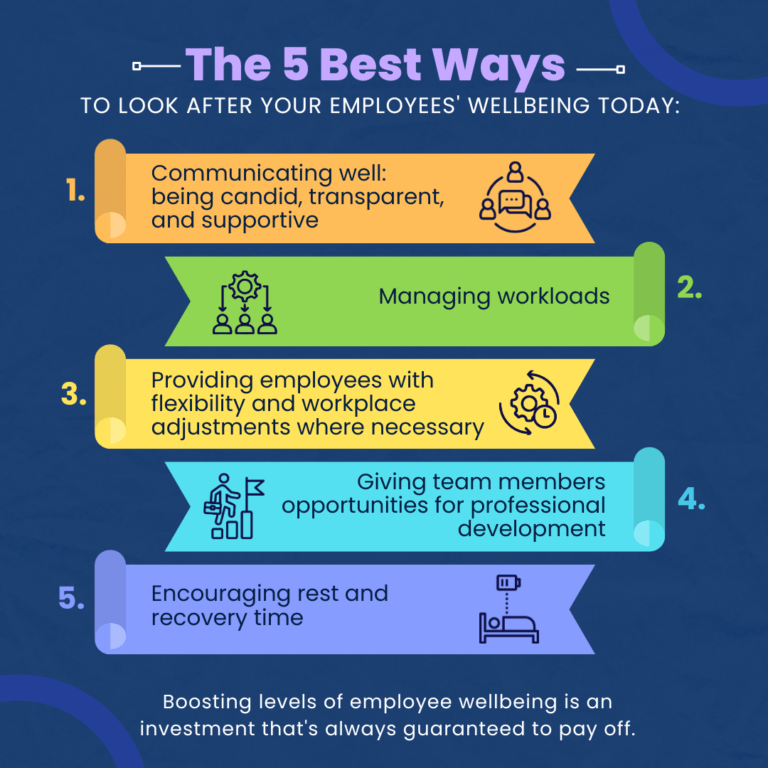The success of any business relies on one key ingredient: high levels of employee wellbeing. A workforce of healthy and happy employees can maximise an organisation’s productivity levels and create a collaborative, positive working environment where all members of staff can flourish.
As direct supervisors, line managers are in the best position to gain a comprehensive understanding of their team members’ wellbeing needs. By looking after their staff and prioritising their health and happiness, they can propel their teams and the overall business to new levels of success.
In the ninth instalment of our line management blog post series, Thrive4Life will explore some ideas for strategies line managers can use to promote employee wellbeing. Get ready to transform your workplace!
You’re reading a blog post from our Line Management series
Below are links to all the posts in this series:

Wellbeing at Work: What Does Employee Wellbeing Look Like?
Before line managers can promote wellbeing in the workplace, it is important to have a holistic understanding of the many different aspects of employee wellbeing. This includes physical health, mental wellbeing, work-life balance, and personal development. This understanding will allow line managers to gauge whether their management practices are supporting employee wellbeing enough, or if there’s more they could do to make sure their team is happy and comfortable at work.
At Thrive4Life, we suggest promoting the following 5 aspects of employee wellbeing:
- Physical Health: It’s important that employees should feel physically healthy at work. This means keeping free of workplace injuries and knowing how best they can support their physical wellbeing.
- Mental Health: The workplace should not negatively impact employees’ mental health. This means there should be strategies in place that mitigate risks of workplace stress and anxiety.
- Job Satisfaction: Employees should feel fulfilled in their roles and responsibilities. They should be made aware of growth opportunities and offered support with career advancement.
- Engagement: Employees should feel engaged and fully integrated into their team, their management, and the organisation they work at. They should feel invested in their overall professional success, showing signs of motivation and ambition.
- Work-Life Balance: Employees should have manageable workloads and office tasks should not infringe upon their personal time after working hours. An employee’s personal life should not be impacted by their professional duties.
By focusing on these key aspects of employee wellbeing, line managers can establish a solid foundation for health and wellbeing promotion. They can then implement targeted initiatives that maximise employee wellbeing in each area, depending on the needs of their organisation.
For example, if work-life balance is detected as a common issue in their workplace, line managers should aim to put in place steps that help employees to better manage their workload and make sure they’re not being overwhelmed with too many tasks. We’ll be exploring wellbeing-boosting management tips in the next section, so keep reading!
Physical and mental health are the two main areas that can significantly influence employee wellbeing.
-
Current data indicates that so far in 2023, approximately 76% of employees are experiencing moderate to high levels of work-related stress – a 13% rise from 2022, and the year isn’t out yet.
-
41% of employees are also reporting musculoskeletal pain from work-related activities.[ref] This shows just how important it is for line management and employers to take active measures to improve the physical and mental wellbeing of employees in their workplaces.
Line Management and Wellbeing Promotion: Tips and Suggestions
Improving workplace wellbeing promotion doesn’t have to add additional strain to line managers’ workloads. Often, they can simply adjust their existing management strategy to include the aforementioned wellbeing standards as targets.
At Thrive4Life, we suggest the following 5 Strategies to help line managers meet employee wellbeing standards:

- Candid, Transparent, and Supportive Communication: Line managers need to be as open as possible when it comes to communicating with employees. This can help promote a culture of understanding and empathy in the workplace. This involves encouraging employees to approach them when they need support with anything – this might include concerns about meeting a professional target or worries about a health issue that’s affecting their work. They should a schedule 1:1 session with the affected employee to ensure privacy and confidentiality. In these types of meetings, it’s also important for line managers to verbally affirm their employees’ feelings and struggles. Simple phrases like “I understand” or “Please feel free to speak about anything that’s bothering you” can help employees open up and feel comfortable communicating their worries with more ease.
- Workload Management: As mentioned above, workload management can help improve an employee’s work-life balance. It’s crucial that line managers strive to make their team’s targets as manageable as possible. This involves offering reasonable deadlines for projects, tracking progress informally to make sure employees are not struggling, and offering to help out or further delegate work where necessary.
- Flexibility and Adjustments: Line managers should be flexible and accommodate employee wellbeing needs in the office. Hybrid working is now an integral part of our working culture. It can be helpful where an employee has health issues that would better suit them working from home. Similarly, line managers should offer reasonable adjustments in the physical workplace. This should include adequate lighting, wheelchair-friendly desks and office layout, and ergonomic equipment (e.g., adjustable chairs and workstations with the correct DSE set-up). (link to the DSE assessments T4L provides here).
- Opportunities for Professional Development: By offering career advancement and skill-building opportunities, line managers can help improve an employee’s job satisfaction and bolster their sense of job security. Line managers should organise training workshops for employees to gain new professional skills, offer invitations to conferences and industry events for networking opportunities, and schedule mentoring and coaching sessions with team members to chat about their career and offer them advice. Such measures can help alleviate stress and anxiety about an employee’s professional future and make them feel valued by the company.
- Encouraging Rest and Recovery Time: Line managers must support employees in their recovery from physical and/or mental health issues. They should encourage employees to take time off from work to recover from illness or injury and help them organise their leave to prevent stress or worry. Line managers should also collaborate with staff to create reasonable return-to-work plans that help employees smoothly transition back into the workplace after a period of absence from poor health. Making sure an employee takes adequate rest and recovery time can allow them to fully recover, meaning they’re much more likely to be more productive and ready to work again upon returning to the workplace. This level of awareness can also help avoid more serious issues of presenteeism and absenteeism (i.e., employees continuing to come to work when ill or habitually remaining absent from work).
By incorporating a focus on these strategies into their management practices, line managers can promote and boost levels of employee wellbeing. To make wellbeing promotion even more simple for line managers, the next section of this blog post will highlight the best resources and tools to use for day-to-day employee wellbeing management.
A focus on employee wellbeing not only benefits your workforce but the entire organisation!
Employees who experience high levels of wellbeing at work are 3 times more likely to stay working at your organisation. They are also 3 times more likely to recommend your organisation to others.[ref] Therefore, by looking after your team members’ wellbeing, line managers can help accelerate employee engagement and build your business’ reputation!
With effective resources, line managers can promote wellbeing in the workplace with confidence and success. At Thrive4Life, we suggest the following 7 resources to improve wellbeing promotion:
- Employee Wellbeing Hub: Thrive4Life’s Health and Wellbeing Discovery Hub is an all-in-one wellbeing resource that line managers and their employees can consult to learn more about mental and physical health and wellbeing. This e-learning database contains an extensive, ever-expanding library of fascinating video and written content that can help individuals better support their own health.
- Wellbeing Consultancy: Thrive4Life offers a dedicated wellbeing consultancy service to help businesses best identify, understand, and cater for the wellbeing needs of their employees. Our team of highly-experienced health professionals can help businesses assess their employees’ health needs, evaluate workplace health risks, and design a bespoke strategy that suits the requirements of their team. This professional guidance can help businesses outline the most effective strategy for wellbeing promotion in their workplace.
- Mental Health First Aid Course: Our Mental Health First Aid course gives line managers the opportunity to gain an MHFA England accreditation, becoming Mental Health First Aiders in the workplace. The specialised mental health skills and training provided in this course can equip line managers with the tools, knowledge, and experience needed to become in-house mental health support for their employees.
- Mental Health Skills Development: Once line managers become accredited Mental Health First Aiders, they can further develop, refresh, and augment their skills and training with our Mental Health Skills Development course. This course will also give them the opportunity to seek further mental health and wellbeing advice and organisation-specific guidance from course leaders.
- DSE Assessor Training: If relevant to their workplace, to boost and safeguard the physical wellbeing of their team members, line managers should also train to become on-site DSE Risk Assessors. Our sister company, Osteopaths for Industry, offers a DSE Assessor Training course that is structured to equip attendees with risk reduction strategies, knowledge of musculoskeletal disorders, and a better understanding of how best to comply with health and safety regulations in the workplace.
- Line Management Training – Managing Stress and Mental Health: Did you know that only 24% of managers have received formal training on managing their team members’ mental health? Our 90-minute line management training course can be delivered either online or in-person. It’s designed to equip line managers with the necessary skills to effectively and confidently manage their team’s stress levels and overall mental health. This course helps line managers become more attuned to the factors that could be impacting their team members’ mental health on a daily basis, teaching them the best practices and support mechanisms they can employ to create an effective, supportive workplace mental health strategy.
- Wellbeing Champion Training: Wellbeing Champions are volunteers within your workforce who can be trained to raise awareness of the importance of mental and physical wellbeing, offer fellow employees support with their wellbeing, and drive positive cultural change within your organisation. They can work alongside Wellbeing Ambassadors, who include both staff and management members, to implement strategies to help create a healthy work environment. Champions are trained to identify colleagues struggling with their mental or physical health and guide them towards appropriate resources. Our Wellbeing Champion course also teaches attendees about the wide range of factors that affect employee wellbeing, equipping them with the necessary communication skills to promote awareness of workplace health and wellbeing and put new health-promoting initiatives into motion. We’ll train your Wellbeing Champions to become leaders in challenging stigmas and starting conversations about wellbeing in your workplace.

In Summary
By prioritising open communication, work-life balance, flexibility, and creating a safe and healthy working environment for all employees, line managers can pave the way to higher levels of employee wellbeing.
As we have explored in this blog post, a positive employee experience at work is predicated on a management style that sees employee wellbeing as the highest priority. Line managers thus hold the power to bring about effective and lasting change in their organisations that nurtures happy, healthy employees who are ready to work to the best of their ability. By following our recommendations and consulting the resources provided, line managers can transform their workplace into a thriving hub of health and productivity. The journey to wellbeing begins today – line managers, let’s take the first step!
References
- Employee Wellbeing Statistics – UK 2023. Champion Health.
- Supporting Your Employee Wellbeing Strategy. Great Place to Work.
- Non-judgemental Listening. Blog post, Lloyd’s Wellbeing Centre.
- Top Tips to Reduce Work-Related Back Pain. Blog post, Lloyd’s Wellbeing Centre.
- Coping with Stress. Blog post, Lloyd’s Wellbeing Centre.
Please note, these are external links away from the Thrive4Life website. We are not responsible for the content of external websites.










